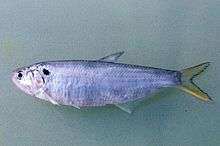Thryssa mystax
| Moustached thryssa | |
|---|---|
 | |
| Thryssa mystax | |
| Scientific classification | |
| Kingdom: | Animalia |
| Phylum: | Chordata |
| Class: | Actinopterygii |
| Order: | Clupeiformes |
| Family: | Engraulidae |
| Genus: | Thryssa |
| Species: | T. mystax |
| Binomial name | |
| Thryssa mystax (Bloch & Schneider, 1801)[2] | |
| Synonyms | |
| |
The Moustached thryssa (Thryssa mystax), also known as Gangetic anchovy, is a species of oceanodromousray-finned fish in the family Engraulidae. It is found in the tropical western Indo-Pacific region from India, Sri Lanka to Myanmar and south to Java, and Indonesia.[3]

It is a small schooling fish found in depth of 0-50m. Maximum length do not exceed 15.5 cm. The fish has 11 to 12 dorsal soft rays and only present 29 to 37 anal soft rays. There are 24 to 32 keeled scutes from isthmus to anus on belly region. Lower gill rakers are serrated. Body is silver, darker dorsally. There is a distinctive dark blotch behind upper part of gill opening, which can easily identify the species from other Thryssa species. Caudal fin is yellowish.[4] It feeds on planktons, fish larva, and small crustaceans like shrimp larva.
See also
References
- ↑ Munroe, T.A. (2010). "Thryssa mystax". IUCN Red List of Threatened Species. Version 2013.2. International Union for Conservation of Nature. Retrieved 2015-05-18.
- ↑ "Thryssa mystax (Bloch & Schneider, 1801)". FishBase. Retrieved 2015-05-18.
- ↑ http://www.iucnredlist.org/details/155240/0
- ↑ http://www.kahaku.go.jp/research/db/zoology/FishGuide/data/fish124.html
